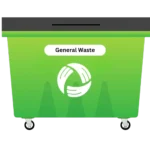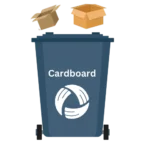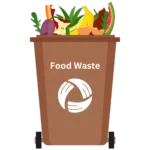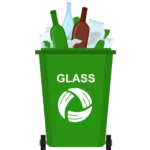Gym Waste Collection
Get a FAST & FREE quote for Gym waste collection
Just enter your gym’s postcode…
Get a FAST & FREE quote for Gym waste collection
Just enter your gym’s postcode…
Start saving now
Effective gym waste collection is important for keeping your premises clean, hygienic, and compliant with waste disposal regulations.
Whether you run a small fitness studio or a large gym facility, arranging reliable waste collection helps maintain a tidy and welcoming environment for members.
We can help you arrange gym waste collection. Simply follow these three steps to get started:

Enter your postcode above and provide some basic details about your gym’s waste collection needs.

Our experts will assess your waste requirements and provide a tailored quote encompassing all waste types.

Once you’re happy with the quote, sign the commercial waste contract to confirm your service.
We make gym waste collection easy, reliable, and cost-effective. Our tailored approach ensures your gym stays clean and compliant.

Our experts understand gym waste collection needs. From recycling to hygiene waste, we’ll provide you with the right service to keep things simple.

We partner only with reliable, trusted waste providers to deliver quality commercial waste management for your gym.

We handle everything from start to finish, so you can focus on running your gym without the stress of waste management.
Gyms produce a variety of waste types, each requiring proper handling and disposal. Below are the main categories of waste produced in gyms and how they are managed.

General waste includes non-recyclable items such as used paper towels, snack wrappers, and other mixed waste that cannot be recycled. This waste is collected in commercial waste bins and sent to a nearby waste to energy facility.

Commercial dry mixed recycling includes clean and uncontaminated recyclable materials commonly found in gyms, such as plastic water bottles, paper and aluminium cans. These items can be collected together and sent for recycling.

Gyms often generate commercial cardboard waste from deliveries of gym equipment, protein supplements, and other packaged products. Flattened boxes are collected separately and recycled into new cardboard products.

Sanitary waste obligations for businesses require gyms to separately collect and dispose of sanitary waste from public and staff bathrooms. Regular sanitary waste collection and washroom services help gyms comply with these rules.

Some gyms have cafes or juice bars that generate commercial food waste. This can include fruit peels, food scraps, protein shakes and expired produce. Food waste is collected separately and processed through composting or anaerobic digestion.

For gyms with refreshment areas or smoothie bars, commercial glass waste such as bottles and jars may need to be collected separately for recycling. Glass is 100% recyclable and can be reused indefinitely.
We provide reliable gym waste collection services nationwide, ensuring fitness centres, studios, and health clubs can manage their waste efficiently. No matter where your gym is located, we can arrange tailored services to keep your premises clean and compliant.

Our trusted providers support gyms across the city with expert waste services. Whether you need general waste disposal, commercial dry mixed recycling, or other waste streams, our London commercial waste collection services are designed to meet your needs.

We offer reliable waste collection for gyms in Manchester. Our Manchester commercial waste collection services cover general waste, commercial cardboard waste, and more to keep your gym clean and compliant.

Tailored waste collection services are available for gyms in Birmingham. Our Birmingham commercial waste collection services include separate collections for recyclables, ensuring efficient waste management.

Our gym waste collection services in Leeds are designed to help fitness facilities manage waste effectively. With our Leeds commercial waste collection services, we ensure waste is collected on time and handled responsibly.

From sanitary waste to commercial cardboard waste, we provide expert services for gyms in Bristol. Our Bristol commercial waste collection services are ideal for managing your gym’s waste efficiently.

We help gyms in Glasgow manage their waste with cost-effective and reliable collection services. Our Glasgow commercial waste collection services cover all key waste types to keep your gym running smoothly.
Reducing waste in your gym can save money on commercial waste collection costs, improve efficiency, and help maintain a cleaner environment for members. Here are practical strategies to minimise commercial waste in your gym:

Encourage members to bring reusable water bottles by installing refill stations. This reduces the need for single-use plastic bottles or cups and reduces dry mixed recycling waste.

Place clearly labelled recycling bins in key areas such as reception, workout zones, and staff rooms. Ensure separate bins are available for dry mixed recycling, cardboard, and general waste.

Reduce paper waste by moving member communications online. Digital sign-in systems, email newsletters, and app notifications can replace printed materials.

Replace disposable wipes with reusable cloths and washable mop heads. This reduces both general waste and sanitary waste.

Purchasing gym supplies like protein supplements, cleaning products, and toiletries in bulk can reduce commercial cardboard waste and packaging materials.

Training staff and providing clear signage for members can encourage better recycling habits and improved waste management.
Unwanted gym equipment doesn’t have to end up in landfills. Here are some practical ways to manage it responsibly.

You can take your old gym equipment to local commercial recycling centres, which will be sorted and sent for reuse or recycling. This is a practical option for dealing with electronic and electrical gym equipment, reducing environmental impact by diverting waste from landfills.

If your equipment is still in good condition, consider donating it to charities, schools, or sports clubs. Some organisations send gym gear to communities in need, helping to reduce waste while supporting good causes.

Broken gym equipment may still have valuable parts like cables, weights, or handles that can be reused for repairs or sold as spares.

For broken or unfixable equipment, booking a one-off waste collection is a simple solution. Many services will recycle what they can, reducing the environmental impact of disposal.

For businesses replacing large amounts of equipment, commercial removal services can collect, recycle, donate, or resell items, helping to keep waste out of landfill.

Selling on platforms like eBay gives your equipment a second life and reduces unnecessary waste.